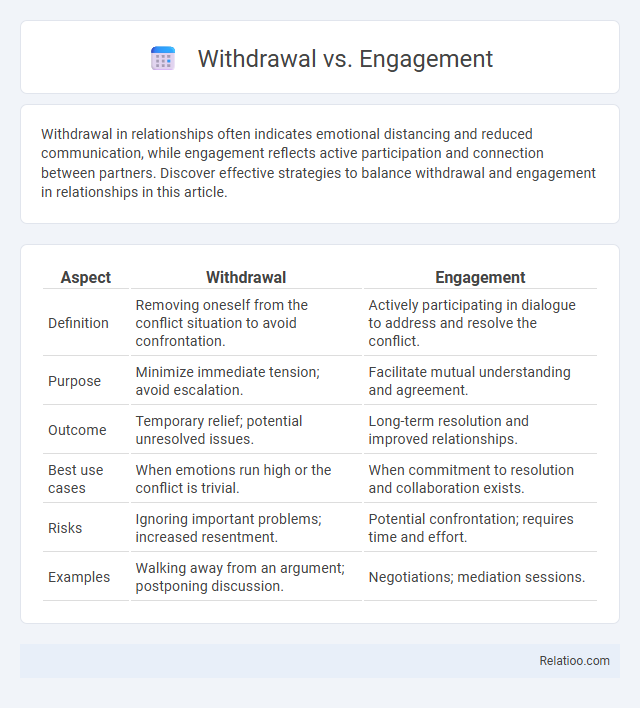Withdrawal in relationships often indicates emotional distancing and reduced communication, while engagement reflects active participation and connection between partners. Discover effective strategies to balance withdrawal and engagement in relationships in this article.
Table of Comparison
| Aspect | Withdrawal | Engagement |
|---|---|---|
| Definition | Removing oneself from the conflict situation to avoid confrontation. | Actively participating in dialogue to address and resolve the conflict. |
| Purpose | Minimize immediate tension; avoid escalation. | Facilitate mutual understanding and agreement. |
| Outcome | Temporary relief; potential unresolved issues. | Long-term resolution and improved relationships. |
| Best use cases | When emotions run high or the conflict is trivial. | When commitment to resolution and collaboration exists. |
| Risks | Ignoring important problems; increased resentment. | Potential confrontation; requires time and effort. |
| Examples | Walking away from an argument; postponing discussion. | Negotiations; mediation sessions. |
Understanding Withdrawal and Engagement
Withdrawal involves retreating from social interactions or activities, often as a coping mechanism to avoid stress or discomfort. Engagement refers to active participation and connection with people or tasks, promoting mental well-being and personal growth. Understanding the balance between withdrawal and engagement helps identify healthy boundaries and prevents excessive escapism, which can lead to isolation or avoidance behaviors.
Key Differences Between Withdrawal and Engagement
Withdrawal involves retreating from social, emotional, or physical interactions, often characterized by avoidance and isolation, whereas engagement reflects active participation and connection with people or activities. Withdrawal can signal underlying issues like anxiety or depression, leading to decreased motivation and reduced responsiveness, while engagement typically promotes mental health through involvement and meaningful experiences. The core difference lies in withdrawal's tendency to foster detachment and passivity, contrasting with engagement's emphasis on interaction and proactive involvement.
Psychological Roots of Withdrawal
Withdrawal often stems from underlying psychological factors such as anxiety, depression, or trauma, manifesting as a defense mechanism to avoid stress or overwhelming emotions. Unlike engagement, which involves active participation in social or environmental activities, withdrawal represents a retreat characterized by reduced interaction and emotional numbness. Escapism, while also a temporary avoidance strategy, differs by seeking alternative realities rather than complete social or emotional detachment seen in withdrawal.
Factors Fueling Engagement
Factors fueling engagement stem from intrinsic motivation, social connections, and meaningful activities that provide purpose and fulfillment. Your brain's reward system activates through positive feedback loops involving dopamine release, reinforcing active participation and sustained interest. Environmental stimuli, personal goals, and emotional resonance contribute to deep involvement, differentiating engagement from withdrawal or escapism patterns.
Signs and Symptoms of Withdrawal
Withdrawal manifests through physical and psychological symptoms such as irritability, anxiety, fatigue, and cravings when You reduce or stop a substance or behavior. Signs include mood swings, restlessness, difficulty concentrating, and sometimes physical ailments like sweating, tremors, or nausea. Recognizing these symptoms early is crucial to addressing underlying dependencies and preventing relapse.
Benefits of Fostering Engagement
Fostering engagement enhances your mental well-being by promoting active participation and meaningful connections, which counteracts the isolation seen in withdrawal. Engagement stimulates cognitive functions and emotional resilience, helping to build stronger social bonds and a sense of purpose. Unlike escapism, which can mask problems, engagement encourages confronting challenges constructively, leading to personal growth and improved life satisfaction.
Workplace Impact: Withdrawal vs Engagement
Workplace withdrawal manifests as reduced productivity, increased absenteeism, and diminished employee morale, directly impacting organizational performance. Employee engagement drives innovation, collaboration, and retention, fostering a positive and dynamic work environment. Your leadership strategy should prioritize boosting engagement to counteract withdrawal behaviors and enhance overall workplace effectiveness.
Strategies to Reduce Withdrawal
Strategies to reduce withdrawal focus on fostering meaningful social connections and promoting active participation in community activities that align with Your interests. Encouraging gradual exposure to social environments and offering support through counseling or peer groups can help individuals build confidence and reduce feelings of isolation. Integrating mindfulness practices and engaging in hobbies also provide constructive outlets, mitigating the urge to withdraw.
Encouraging Engagement in Teams
Encouraging engagement in teams boosts collaboration, productivity, and morale, reducing tendencies toward withdrawal or escapism. Your leadership can foster active participation by creating inclusive environments where team members feel valued and motivated to contribute. Practical strategies include setting clear goals, providing regular feedback, and promoting open communication to maintain focus and connection within the group.
Long-Term Effects: Withdrawal Versus Engagement
Withdrawal often leads to social isolation and diminished mental well-being, increasing the risk of anxiety and depression over time. In contrast, engagement promotes cognitive growth, emotional resilience, and stronger social connections, contributing to long-term psychological health. Your choice to engage actively in life fosters sustained personal development, whereas withdrawal may result in a cycle of disengagement and deteriorating mental health.

Infographic: Withdrawal vs Engagement
 relatioo.com
relatioo.com